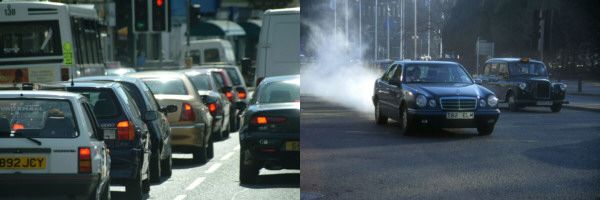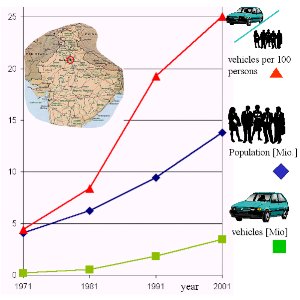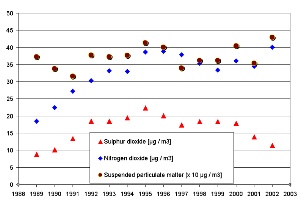|
|
 |
|
|
|
 |
| |
|
|
 |
Climate in cities
Read more |
Fuel combustion in energy production and transportation
Energy production and transportation cause emissions of many substances produced during the combustion of coal, gas, oil and various kinds of petrol produced from them. Every fuel delivers air pollution of a bit different chemical composition. |
|
|
|
|
 |
|
The majority of electricity produced in the world is obtained as a result of oil, coal and earth gas combustion. That process is accompanied by the emission of huge amounts of various kinds of air pollution, depending on the substance being used. Earth gas is considered to be a rather clean fuel, Diesel fuel (a sort of petrol) causes emission of carbon dioxide (CO2), sulphur dioxide (SO2) and nitrogen oxides (NOx), but burning the coal is the most burdensome. It is accompanied by the emission of both gases and dust. The emitted gases consist of SO2, NOx, CO (carbon monoxide), CO2, and the dust contains heavy metals (lead, zinc, cadmium). Burning fossil fuels in the whole Europe in 1998 delivered to the air about 5,670,000 thousand tonnes of CO2. From all the fossil fuels, the content of sulphur is the highest in coal, but varies significantly due to the type of coal. Sulphur emissions from energy production contribute significantly to acid rains (see part "Acid rain origin").
|
 |
 |
|
1. Energy production and air pollution
Above: coal power station - cooling towers (to the left) and power complex (to the right)
Below: nuclear power station (to the left) and water power station (to the right)
Source: www.freefoto.com
Source: Climate Action Network Central And Eastern Europe
|
|
In some countries the majority of electricity is obtained from other sources than fossil fuels, which improves significantly the air quality in both regional and global scale. For example, in France about 65% of electricity is obtained from nuclear power plants, and in Norway over 90% comes from hydrologic power plants.
|
 |
 |
|
2. Urban traffic and air pollution
Source: www.freefoto.com
|
Transportation has a significant share in the global air pollution, and in the high developed countries it even exceeds the share of industry. In global scale, cars deliver every year about 300 million tonnes of toxic exhaust gases into the atmosphere. The exhaust gases from car engines working on petrol contain CO and NOx, hydrocarbons, SO2 and solid particles, while engines operating on Diesel fuel emit less toxic gases (e.g. 20 times less CO, 8 times less hydrocarbons), but more soot. In Europe and North America, only 10% of NOx delivered into the air is of natural origin; the remaining 90% comes mainly from fossil fuels combustion in high temperature, e.g. in cars' engines (1,200-1,800°C). Transportation used to deliver to the atmosphere huge amounts of lead, especially in the years 1940-1960, when lead was added to petrol to improve its combustion in the engine. Later, an unleaded petrol was introduced, first in USA, and has gradually replaced the lead-containing one.
In the 1970s, one bus engine produced during 1 hour about 1000 m3 of exhaust gases, which contained 3.5 g of lead (which is 3500 µg/m3). Just to compare: today, in the European Union the allowed level is 5 µg/m3 of air (not exhaust gases!) in 30 minutes. Moreover, especially in the developed countries, the unleaded petrol is used, and therefore transportation's lead emission decreased significantly. The effects of lead and other heavy metals' impact on people may be often seen after a rather long time, as they cumulate in human body and act gradually.
|
 |
 |
 |
|
3. Growth in Transport Sector in Dehli / India
Please click to see enlarge! (83 K)
data source: Gurjar, Lelieveld and van Aardenne, 2003 / GNCTD, 2002
Author: Elmar Uherek
|
|
In the European Union, marketing of leaded petrol has been prohibited since 2000. Additionally, engines working on Diesel fuel do not emit lead. Dust delivered by the transportation to the air comes not only from burning the fuels, but also from detrition of roads' surfaces and cars' tires and breaks. At present, most cars are equipped in catalytic converters which significantly reduce the amount of emitted pollution. On the other hand, the number of cars still increases, making the issue still relevant. The example of Dehli (see figure above) shows how population growth is accompanied with the increase of the number of cars. Next figure shows that main air pollutants in Dehli are those delivered by transportation (NO2), not by energy production (SO2). Moreover, catalytic converters cause emission of very fine particles of heavy metals, e.g. platinum, palladium and rhodium, but their impact on the natural environment is still unknown.
|
 |
 |
 |
|
4. Air quality in Dehli / India
Please click to see enlarge! (58 K)
data source: Gurjar, Lelieveld and van Aardenne, 2003 / GNCTD, 2002
Author: Elmar Uherek
|
|
|
Another mean of transportation polluting the atmosphere is air-plane. One jet-plane emits as much gas pollution as 7,000 cars working in the same time. Unlike cars, air-planes deliver the pollution also to the higher atmosphere, even effecting stratospheric ozone.
|
 |
 |
|
5. Air transport and air pollution
Source: www.freefoto.com
|
|
About this page:
Authors: Pawel Jezioro, Anita Bokwa - Jagiellonian University - Cracow / Poland
Supporter: Grzegorz Wawrejko
1. Scientific reviewer: Prof. Barbara Obrebska-Starkel - Jagiellonian University - Cracow / Poland - 2003-06-20
2. Scientific reviewer: Dr. Marek Nowosad - Maria Curie-Sklodowska University - Lublin / Poland - 2003-06-16
educational reviewing:
last update: 2003-08-20
|
|
 |
|









